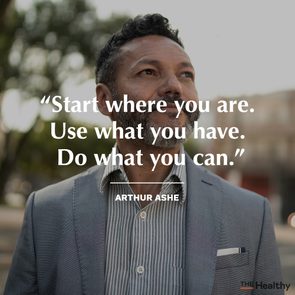How to Manifest Something You Want: A Guide
Updated: Mar. 15, 2021
Learning how to manifest something starts with understanding what manifestation is—and what it's not. Here's how to utilize this practice, according to therapists.
Our editors and experts handpick every product we feature. We may earn a commission from your purchases.
Is manifestation real?
It depends on who you ask. The practice of manifestation involves bringing something into your life through intentional action and belief. Some people consider it a strategy to help you get what you want. Others think of it as just another word for wishful thinking.
So the “realness” of manifestation depends on how you define it and how you work to implement it.
“Since manifestation is basically the notion that our intentions, thoughts, and emotions lead us to materialize certain things in our lives, it’s certainly possible to manifest,” says licensed mental health counselor Denise Fournier, PhD, an adjunct psychology professor at Nova Southeastern University in Florida. On the other hand, she adds, manifestation is sometimes thought of as a form of magic wielded by people who think positively. “Seen in this reductive way, nobody should take the concept very seriously.”
With the right understanding and strategy, however, it’s possible to manifest, says Paul Hokemeyer, PhD, a clinical and consulting psychotherapist in New York and author of Fragile Power: Why Having Everything Is Never Enough.
“This is because manifestation enables us to articulate our goals and come up with a strategy to attain them,” he says. But “to be successful, the goals to be manifested must be clear, authentic, and directed to the betterment of self and humanity.” (Here are some goal-setting tips.)
Here’s what therapists want you to know about how to manifest.

The benefits of manifestation
Manifestation highlights the importance of thought patterns, which is foundational in any conversation about mental health, says Fournier. Thoughts matter. And they may shape your feelings, actions, and experiences. (Here’s how reframing your thoughts could change your life.)
Another benefit of believing in manifestation: It may motivate you to reach your goals. The combination of intention, attention, and excitement about the future—key parts of manifestation—can positively impact mental health, Fournier says.
In fact, parts of manifestation already exist in therapy. Most therapists help people examine their thoughts and understand the connection between those thoughts and their emotions and experiences, she adds. Successful therapy has clear goals—just like manifestation.
People who benefit the most from manifestation practices
People with discipline, self-motivation, and healthy self-esteem are the best candidates to apply manifestation in their lives, according to Hokemeyer.
You’re a good candidate for manifestation so long as you approach manifestation in a grounded way, says Fournier. Once you’ve set, focused, and aligned your thoughts, emotions, and beliefs according to what you desire, you need to be ready to take action, make choices, and even make sacrifices for your desires to fully manifest, she says. People who understand that will see the most success with manifestation.
People who benefit from manifestation also realize that there are limitations to the concept, and that there are real societal factors that can pose barriers to success.
“We need to be very careful about how we think and talk about manifestation,” she says. Otherwise, “we run the risk of assuming that people who live in conditions less fortunate than our own are manifesting their circumstances because they aren’t thinking positively.”
Even though our focus, feelings, thoughts, and beliefs can create our experience, not every life experience is subject to this formula, adds Fournier. People who understand all of the above will see the most success with manifestation.
People who may not benefit from manifestation practices
Although some people may see positive changes with manifestation, that doesn’t mean it’s a good fit for everyone, especially those with mental health issues like anxiety or depression, Hokemeyer says.
Having these issues may mean you’re more likely to have negative thoughts. If people with these conditions believe in manifestation as a form of wishful thinking, they may incorrectly believe that simply thinking negative thoughts will bring them to life. That’s why it’s essential not to teach manifestation simplistically, Fournier says. “We need to ground the conversation and think about it in balanced terms. Otherwise, the logic of it is pretty toxic.”
Other people who should avoid manifestation, according to Fournier, include those with psychopathy, sociopathy, or antisocial behavior who may want to use the practice to exploit or harm other people.
Even if you don’t suffer from a mental health condition, misunderstanding manifestation can lead to problems. The only way to benefit from manifestation is to understand its limits and how it works. So if you think that manifestation is only about hoping, optimism, or magical thinking, it’s not going to be a useful practice. (What is toxic positivity?)
Remember that good thoughts alone do not necessarily bring about good things or events in our lives, says Caroline Hexdall, PhD, a clinical psychologist at the Center For Mindful Development in Chapel Hill, North Carolina. “There will always be circumstances in our lives that are out of our control—with or without the practice of manifestation.”
How to manifest, according to therapists
Articulate a goal
Take time to center yourself, so you are truly listening to yourself to consider what it is you want, Hexdall says. Be specific and simple. Write down what that goal would look like once you accomplish it, Hokemeyer advises. Get clear about your intentions and desires.
Build awareness
Become aware of your thoughts, and shift them to be consistent with having or experiencing what you intend and desire, Fournier says. “Tap into the emotional state consistent with receiving what you intend and desire,” she says.
Ask for what you want
Then ask for what you want through meditation, prayer, or visualization. To get your visions out of your mind and out in the open, try using a vision board, poster with pictures, and sayings of how you want to experience life, suggests Hexdall. “This step is similar to making a goal known to friends and family,” she says. “It typically increases the commitment we have to reach our goals.”
Come up with an action-focused plan
Step back and figure out what needs to be in place before your goal is manifested, Hokemeyer says. “Come up with a one-, three-, and five-year plan.” Then break it down and ask yourself what the very first step toward reaching this goal is.
“It may be to start a specific savings account, update your resume, pursue an area of interest you have wanted to learn more about, or learn a skill you need to build,” Hexdall says.
Activate the plan
Take actions that are consistent with receiving what you intend and desire. The best way to manifest positive results in your life is through small and consistent actions.
“If you want to lose 10 pounds, for example, focus on the incremental pounds to lose rather than the final goal,” Hokemeyer says. “If you want to manifest a healthy planet, monitor your single-use plastic consumption, and pick up the litter along your path.” (Manifestation practices could be a good addition to your self-care plan.)
Check-in
Remind yourself along the way that you are worthy of reaching this goal or having this desire met in your life. And accept that it may not manifest itself in the exact way you desire, Hexdall notes. (Here are the benefits of being kind to yourself.)
Look for signs of small shifts in your life that are moving you more toward the goal. These could be subtle, but need appreciation and notice, according to Hexdall. “Some signs may be less resistance toward the actions you are taking or more willingness to try new steps,” she says.
Remember to stay patient and stay the course. Carving a new path takes awareness, resistance to habit, as well as effort and dedication to rebuilding the new path, Hexdall says.

Therapist-approved tips on how to manifest
Start with awareness
“The most important part of manifestation that I would want people to take away more than anything else, is that what you focus on expands,” Fournier says. “Instead of thinking about manifestation as a specific practice, think about it as a practice of being intentional, noticing where your attention is going, noticing the nature and quality of your thoughts, and recognizing the power you have over your own internal experience.”
Ask yourself questions
If you’re engaging in all of those things, you will experience meaningful and beneficial changes in your life, according to Fournier.
“Sometimes, manifestation overly focuses on the ‘what’—in other words, the material things you want to receive,” Fournier says. “As far as mental health is concerned, we need to focus more on the ‘how.’ ”
She suggests asking yourself: How do I imagine I will feel when I create or receive what I desire? Why is it important for me to experience those feelings? How can I set myself up, today, to generate that experience for myself? These questions can be a valuable way of breaking the attachment to specific material things, and expanding your ability to shift your experience right now, according to Fournier.
Manifestation loves company
Make sure you are not manifesting in isolation. Join up with someone else who shares your goal. Make sure the goal you want to manifest is healing, either of yourself or others. “Remember that good things come to those who wait and work,” Hokemeyer says. The keyword here is “work.”
Hexdall agrees, adding that manifestation is a process that may yield the best results when practiced with someone else. It may not necessarily be with a therapist or guide of some kind, but perhaps with a trusted friend.
“Through partnered encouragement and accountability, goals, in general, are reached more effectively,” Hexdall says. “This is the action part of manifestation.” (Here’s how to find a therapist.)
Bottom line
The key to healthy manifestation is understanding what manifestation is, consistency in your approach to it, and a willingness to do what it takes to experience what you desire, according to Fournier. “Closing your eyes and wishing for it won’t be enough,” she says.
If you act—asking for what you want, changing your thoughts, and working toward what you want—you’re on the right path to manifestation. Remember to actively appreciate yourself in your work toward reaching your goals, no matter the outcome.
















